Publications
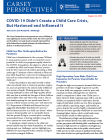
August 24, 2020
In this new Carsey Perspective, authors Jess Carson and Marybeth Mattingly describe the ways that the COVID-19 pandemic has strained the nation’s already-fragile early childhood care systems. Child care providers are struggling to address revenue losses associated with closures, fewer enrollments, and new safety guidelines. Meanwhile, demand for formal child care is shifting in yet-unknown ways,…

June 29, 2020
In this data snapshot, authors Jess Carson and Sarah Boege find that getting food is a problem for people experiencing food insufficiency during the pandemic, but affording food is the biggest challenge.
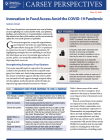
May 18, 2020
The COVID-19 pandemic has triggered income losses and rising demand for food-related support, while social distancing requirements have complicated access to usual nutrition support sites. In response, government agencies, private retailers, nonprofit organizations, and volunteer networks are undertaking innovative efforts to ensure food access by vulnerable populations. By highlighting…
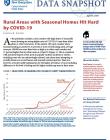
April 8, 2020
In this data snapshot, author Jess Carson finds that rural counties where at least 25 percent of the housing units are for seasonal use are hit especially hard by COVID-19 compared with urban and other kinds of rural counties.
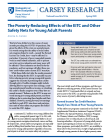
March 31, 2020
In this brief, Jess Carson explores the poverty-reducing effects of key federal safety net programs among 18-24 year old (“young adult”) parents.
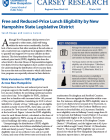
March 19, 2020
This brief translates New Hampshire free and reduced-price lunch eligibility data from the school level to the state House of Representatives legislative district level so that legislators have another resource for understanding the distribution of low-income families across the state and the extent to which child nutrition programs are especially relevant in their districts.
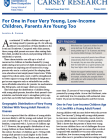
December 12, 2019
This brief maps the distribution of children living with young adult parents, describes their parents’ characteristics, and details ways to strengthen policy supports that can fortify their families’ ability to succeed.
September 26, 2019
In this data snapshot, author Jessica Carson reports that according to analyses of new American Community Survey data released today, nearly one-in-five American children were poor in 2018. While child poverty has finally returned to pre-recession rates, the 0.4 percentage point decline since 2017 continues the trend of incremental decreases in child poverty since the post-recession peak in 2012…

August 13, 2019
In this brief, we use interview and focus group data to explore how residents view the economic opportunities in two rural Northern New England counties and how these opportunities are related to migration patterns.
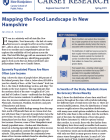
June 11, 2019
In this brief, Jess Carson explores the food landscape of New Hampshire, documenting where lower incomes and low population density might lead to food insecurity, and mapping the locations of various food sources.
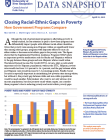
April 25, 2019
Although the role of government programs in alleviating poverty is widely studied, far less attention is paid to how these programs may differentially impact people with different racial-ethnic identities. Given that poverty rates among non-Hispanic whites are significantly lower than among other groups, programs with disparate effects by race can either widen or decrease racial-ethnic gaps in…
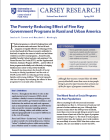
April 16, 2019
Federal programs are critical for helping those with low incomes make ends meet. But not all such programs are equally effective at reducing poverty, nor do they benefit all of those in poverty uniformly.

February 21, 2019
When low-income residents struggle to make ends meet, non-profit social service agencies can help fill the gaps. In doing so, these agencies must find sufficient funding, retain qualified staff, and craft efficient service delivery mechanisms that are respectful of clients and communities. Some of the challenges that service providers encounter are exacerbated by rural characteristics, such as…

November 13, 2018
Increases in the minimum wage are widely assumed to be beneficial for low-income workers, but it is important to consider the effect an increase might have on eligibility for other benefits, particularly the federal Earned Income Tax Credit (EITC). This fact sheet examines the interaction between the minimum wage and the EITC to determine whether a minimum wage increase would produce gains in the…

October 31, 2018
The share of people without health insurance has dropped dramatically since the implementation of the Affordable Care Act (ACA), but declines have been most dramatic among young adults age 19 to 25. In 2008, one-in-three 23-year-olds were uninsured, likely reflecting their graduation from college and therefore, their ineligibility to be covered on parental plans. Beginning in 2010, the ACA…

October 9, 2018
Recent proposals in the House and Senate (for example, the Grow American Incomes Now Act) focus on amplifying the Earned Income Tax Credit (EITC)—a refundable tax credit for low-income workers—to compensate for growing wage inequity. We find that the share of EITC filers who are families with children is especially high in the poorest counties (those counties outlined in black on Map 1),…
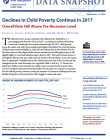
September 13, 2018
The official poverty measure indicates that child poverty declined by 1.1 percentage points between 2016 and 2017, according to analyses of the latest American Community Survey data released today. By 2017, child poverty across the nation was still 0.4 percentage point higher than before the Great Recession. Child poverty remained higher in cities and rural places than in the suburbs. For the…
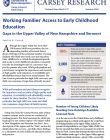
September 5, 2018
Although the Upper Valley has more than 200 licensed child care providers, the corresponding number of licensed slots is about 2,000 short of the estimated number of young children who likely need early care and education. Early childhood is a critical developmental period, and access to early childhood education is essential not only for learning but also as a necessary support for parents who…
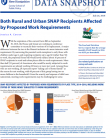
July 26, 2018
With the expiration of the current Farm Bill on September 30, 2018, the House and Senate are working in conference committee to reconcile their versions of its replacement. A major difference between the two is the House’s inclusion of a more intensive work requirement. By narrowing the parental work exemption to only those with children under age 6, and requiring recipients up to age 60 (rather…
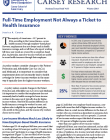
March 20, 2018
The majority of Americans—55.7 percent in 2016, according to the Census Bureau—access health insurance through employer-based plans.1 However, employment does not always result in health insurance coverage, and not all those who report working full time, year round are covered by an employer-based plan. In particular, many low-income workers are unable to access health insurance through their…
